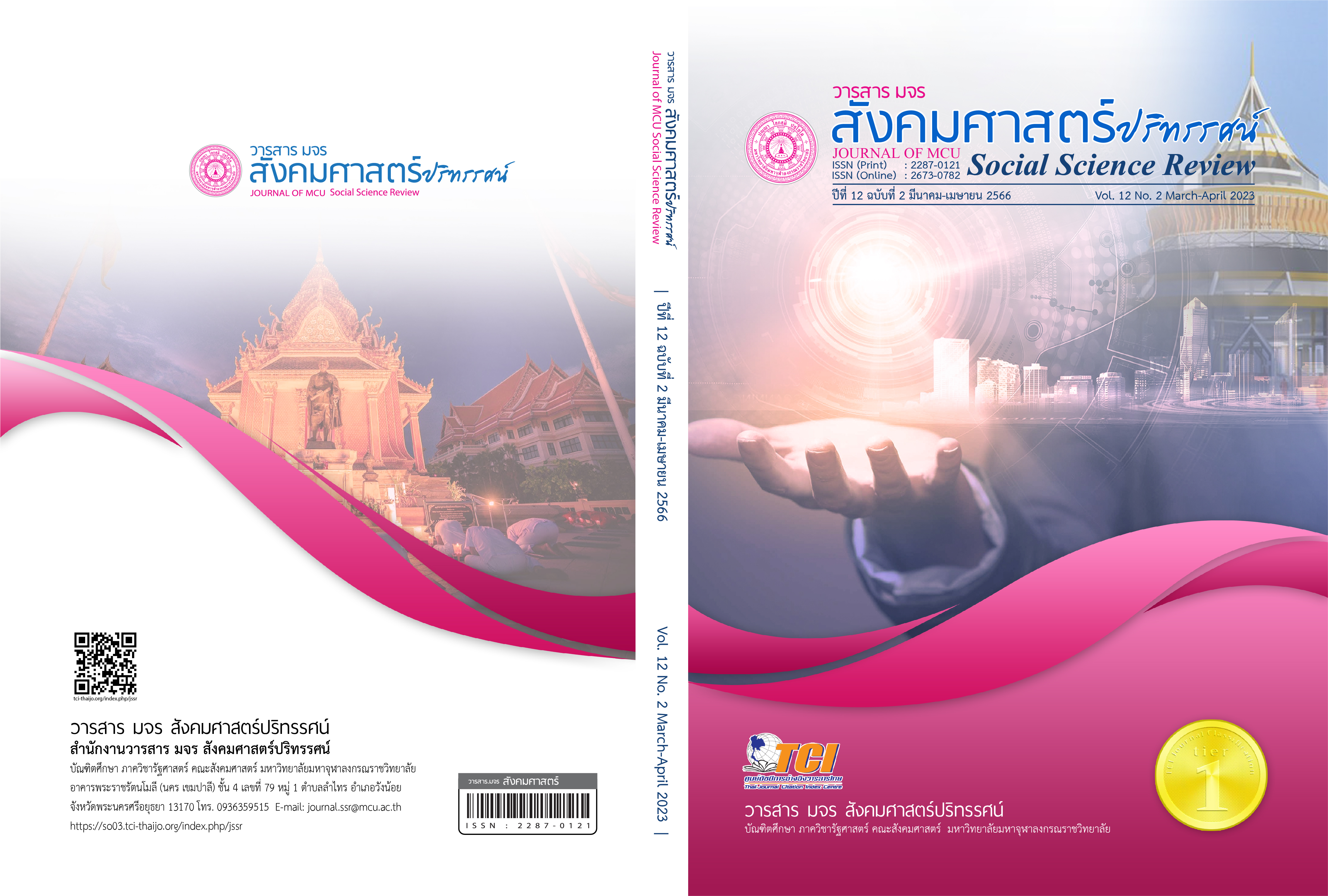ตัวแบบการลดความเสี่ยงภัยแล้งในเขตพื้นที่ภาคเหนือตอนล่าง
คำสำคัญ:
ตัวแบบการลดความเสี่ยง, ภัยแล้ง, เขตพื้นที่ภาคเหนือตอนล่างบทคัดย่อ
การวิจัยนี้มีวัตถุประสงค์เพื่อศึกษาสภาพทั่วไปของปัจจัย พร้อมทั้งสร้างและยืนยันตัวแบบการลดความเสี่ยงภัยแล้งในเขตพื้นที่ภาคเหนือตอนล่าง ใช้วิธีวิจัยแบบผสมวิธี การวิจัยเชิงปริมาณ ใช้แบบสอบถามเจ้าหน้าที่องค์กรปกครองส่วนท้องถิ่น (อปท.) และเจ้าหน้าที่กรมป้องกันและบรรเทาสาธารณภัย (ปภ. เขต/ปภ. จังหวัด) ภาคเหนือตอนล่าง จำนวน 378 คน กำหนดขนาดกลุ่มตัวอย่างตามสูตรทาโร่ยามาเน่ ใช้วิธีวิเคราะห์ค่าเฉลี่ย ร้อยละ ส่วนเบี่ยงเบนมาตรฐาน วิเคราะห์ค่าสัมประสิทธิ์สหสัมพันธ์แบบเพียร์สัน และวิเคราะห์ความตรงโมเดลโครงสร้างความสัมพันธ์เชิงสาเหตุด้วยโปรแกรม Mplus และยืนยันตัวแบบโดยผู้ทรงคุณวุฒิ จำนวน 20 คน ใช้วิเคราะห์ค่ามัธยฐาน ค่าฐานนิยม และค่าพิสัยระหว่างควอไทล์ การวิจัยเชิงคุณภาพ ใช้วิธีจัดประชุมระดมความคิดเห็น จำนวน 20 คน
ผลการวิจัยพบว่า ปัจจัยที่มีผลต่อการลดความเสี่ยงภัยแล้ง ดังนี้ อิทธิพลทางตรง จำนวน 5 ปัจจัย เรียงลำดับค่าสัมประสิทธิ์อิทธิพลทางตรงเรียงลำดับจากมากไปหาน้อย ได้แก่ การบริหารแบบมุ่งผลสัมฤทธิ์ การสื่อสารระหว่างองค์กร นวัตกรรมและเทคโนโลยีสารสนเทศ นโยบายส่งเสริมจากภาครัฐ การมีส่วนร่วมของประชาชน อิทธิพลทางอ้อม จำนวน 3 ปัจจัย ได้แก่ ทรัพยากรในการบริหาร การบริหารแบบมุ่งผลสัมฤทธิ์ นโยบายส่งเสริมจากภาครัฐ และอิทธิพลโดยรวม จำนวน 6 ปัจจัย ได้แก่ การบริหารแบบมุ่งผลสัมฤทธิ์ นโยบายส่งเสริมจากภาครัฐ ทรัพยากรในการบริหาร การสื่อสารระหว่างองค์กร และนวัตกรรมและเทคโนโลยีสารสนเทศ การมีส่วนร่วมของประชาชน
เอกสารอ้างอิง
กรมชลประทาน. (2563). ชป. เปิดศูนย์ฯบรรเทาวิกฤตภัยแล้ง ปี 2563 ลุ่มน้ำน่าน ช่วยเหลือพื้นที่ภัยแล้งภาคเหนือตอนล่าง. สืบค้น 6 กันยายน 2564, จาก https://www.rid.go.th/main/index.php?option=com_content&view=article&id=6001:---2563--&catid=6:2009-04-12-07-50-21&Itemid=7
กรมป้องกันและบรรเทาสาธารณภัย. (2556). คู่มือการป้องกันและบรรเทาสาธารณภัย. กรุงเทพฯ: กรมป้องกันและบรรเทาสาธารณภัย.
________. (2558). แผนการป้องกันและบรรเทาสาธารณภัยแห่งชาติ พ.ศ. 2558. กรุงเทพฯ: กรมป้องกันและบรรเทาสาธารณภัย.
________. (2559). การลดความเสี่ยงจากสาธารณภัย (พิมพ์ครั้งที่ 3) กรุงเทพฯ: กระทรวงมหาดไทย.
________. (2560). กรมป้องกันและบรรเทาสาธารณภัยนำเทคโนโลยีสารสนเทศมาใช้ในการจัดการสาธารณภัย มุ่งสู่การสร้างประเทศไทยปลอดภัย. สืบค้น 7 กันยายน 2564, จาก https://gnews.apps.go.th/news?news=2446.
กรมส่งเสริมการปกครองท้องถิ่น. (2562). มาตรฐานระบบน้ำสะอาด. กรุงเทพฯ: กรมส่งเสริมการปกครองท้องถิ่น.
ขวัญใจ เปือยหนองแข้ และคณะ. (2563). แนวนโยบายการบริหารจัดการภัยแล้งตามแนวทาง การป้องกันและบรรเทาสาธารณภัย. วารสารการบริหารการปกครองและนวัตกรรมท้องถิ่น, 4(1), 284 – 287.
จรัญพัฒน์ ภูวนันท์ และคณะ. (2559). นโยบายการป้องกันและบรรเทาสาธารณภัยกับการพัฒนาที่อยู่อาศัยเพื่อผู้ประสบภัยพิบัติในประเทศไทย. วารสารการจัดการภาครัฐและภาคเอกชน มหาวิทยาลัยวลัยลักษณ์, 3(5), 105 – 107.
ชาญวิทย์ คุณาวิวัฒนางกูร และสุริยจรัส เตชะตันมีนสกุล. (2561). ผลการนำนโยบายการป้องกันและบรรเทาสาธารณภัยขององค์กรปกครองส่วนท้องถิ่น ในอำเภอเมืองเชียง ใหม่ไปสู่การปฏิบัติ. วารสารวิชาการวิทยาลัยบริหารศาสตร์, 1(4), 70 – 80.
นาถนเรศ อาคาสุวรรณ. (2561) การศึกษาพื้นที่เสี่ยงภัยแล้งและแนวทางป้องกันภัยแล้งในพื้นที่คาบสมุทรสทิงพระ. วารสารอินทนิลทักษิณสาร, 13(1), 56- 80.
นิรันดร์ บุญสิงห์ และธรรมนิตย์ วราภรณ์. (2560). นโยบายภาครัฐและการมีส่วนร่วมของประชาชนที่ส่งผลต่อสัมฤทธิ์ผลในการป้องกันและแก้ไขปัญหาภัยแล้ง กรณีศึกษาศูนย์ป้องกัน และบรรเทาสาธารณภัย เขต 13 อุบลราชธานี. วารสารมนุษยศาสตร์และสังคมศาสตร์มหาวิทยาลัยราชภัฏอุบลราชธานี, 8(2), 99 – 107.
เปรมชัย สโรบล. (2550). ปัจจัยการบริหารที่มีอิทธิพลต่อคุณภาพการศึกษาของโรงเรียนนายร้อยพระจุลจอมเกล้า (ปริญญาปรัชญาดุษฎีบัณฑิต สาขาบริหารการศึกษา). กรุงเทพฯ : มหาวิทยาลัยศิลปากร.
พิทักษ์ มั่นจันทึก และศุภณัฏฐ์ ทรัพย์นาวิน. (2558). กลยุทธ์การบริหารด้านการป้องกันและบรรเทาสาธารณภัยของเทศบาล ในเขตอำเภอเมือง จังหวัดเพชรบุรี. วารสารวิชาการ Veridian E-Journal, SilpakornUniversity ฉบับภาษาไทย สาขามนุษยศาสตร์สังคมศาสตร์และศิลปะ, 8(2), 2351-2368.
เพชรรัตน์ แสนทวีสุข. (2552). การบริหารงานด้านการช่วยเหลือผู้ประสบอุทกภัยของ สำนักงานป้องกันและบรรเทาสาธารณภัยจังหวัดอุบลราชธานี (ปริญญารัฐประศาสนศาสตรมหาบัณฑิต สาขารัฐประศาสนศาสตร์). อุบลราชธานี : มหาวิทยาลัยอุบลราชธานี.
ศุภณัฏฐ์ ทรัพย์นาวิน. (2558). กลยุทธ์การบริหารด้านการป้องกันและบรรเทาสาธารณภัยของเทศบาลในเขตอำเภอเมือง จังหวัดเพชรบุรี. Veridian E-Journal, Slipakorn University ฉบับภาษาไทย สาขามนุษยศาสตร์ สังคมศาสตร์ และศิลปะ, 8(2), 2351 – 2357.
Likert, R. (1932). New Patterns of Management. New York: McGraw - Hill.
Simon, H. A. (1972). Sistema Sekkei to Soshikiron (System Planning and Organization Theory. Soshiki Kagaku Organizational Science, (6), 27-34.
Taro Yamane. (1973). Statistics: An Introductory Analysis (3rd EdX. New York. Harper and RowPublications.
ดาวน์โหลด
เผยแพร่แล้ว
รูปแบบการอ้างอิง
ฉบับ
ประเภทบทความ
สัญญาอนุญาต
ลิขสิทธิ์ (c) 2023 วารสาร มจร สังคมศาสตร์ปริทรรศน์

อนุญาตภายใต้เงื่อนไข Creative Commons Attribution-NonCommercial-NoDerivatives 4.0 International License.
เพื่อให้เป็นไปตามกฎหมายลิขสิทธิ์ ผู้นิพนธ์ทุกท่านต้องลงลายมือชื่อในแบบฟอร์มใบมอบลิขสิทธิ์บทความให้แก่วารสารฯ พร้อมกับบทความต้นฉบับที่ได้แก้ไขครั้งสุดท้าย นอกจากนี้ ผู้นิพนธ์ทุกท่านต้องยืนยันว่าบทความต้นฉบับที่ส่งมาตีพิมพ์นั้น ได้ส่งมาตีพิมพ์เฉพาะในวารสาร มจร สังคมศาสตร์ปริทรรศน์ เพียงแห่งเดียวเท่านั้น หากมีการใช้ภาพหรือตารางหรือเนื้อหาอื่นๆ ของผู้นิพนธ์อื่นที่ปรากฏในสิ่งตีพิมพ์อื่นมาแล้ว ผู้นิพนธ์ต้องขออนุญาตเจ้าของลิขสิทธิ์ก่อน พร้อมทั้งแสดงหนังสือที่ได้รับการยินยอมต่อบรรณาธิการ ก่อนที่บทความจะได้รับการตีพิมพ์ หากไม่เป็นไปตามข้อกำหนดเบื้องต้น ทางวารสารจะถอดบทความของท่านออกโดยไม่มีข้อยกเว้นใดๆ ทั้งสิ้น





